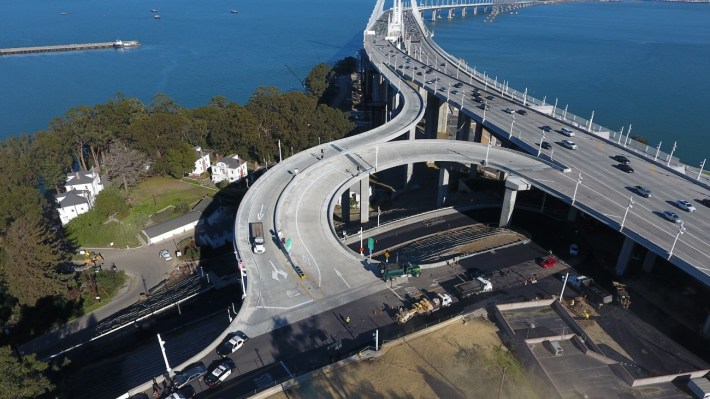About this time last year, advocates celebrated SFMTA's approval of the "Better Market Street" plan. The $500 million plan, which was to built in phases, included rebuilding all under-street utilities and, near-and-dear to advocates for safe streets, included an eight-foot, sidewalk-level protected bike lane (on balance, one of the cheaper components in the plan). But with the cut backs and economic downturn associated with the COVID crisis, city staff presented a stripped-down plan to the San Francisco County Transportation Authority Tuesday that eliminates the protected bike lane.
Our compatriots at the San Francisco Examiner did a great breakdown of the new plan. From the Examiner's story:
Less than a year after its launch, the Better Market Street project is set to be scaled down notably in an effort to cut costs due to the pandemic budget crunch, respond to higher-than-expected volumes of cyclists, and reduce negative impacts on local businesses along the corridor. City staff described the revision, focused on changes to Market Street between Fifth and Eighth streets, at the San Francisco County Transportation Authority Board meeting on Tuesday not as “a forever design” but rather as a series of “difficult” choices intended to better “reflect the current situation in The City.” Opponents say the reduced price tag for the three-block stretch — which is still about $121 million plus an additional $7 million for costs associated with the redesign process — is way too high given the changes’ deleterious impact on the substantive safety improvements the project originally promised.
In this new plan, cyclists will continue to share the street with taxis, trucks, police cruisers and other city vehicles, thus continuing to be exposed to potential collisions on one of San Francisco's most dangerous streets.
"The Better Market Street project took over ten years of hard work. Together we had a bold plan to transform our city’s most important street to be for the people biking, walking, and traveling on it. Now, all the things that made the Better Market Street project transformative are being removed. We understand that the project budget faces challenges, but we must find a design that is safe, sustainable, and transformative for future generations," the San Francisco Bicycle Coalition's Janice Li told Streetsblog.
"I’m depressed. Activists show up on the street. We go to the meetings. We risk our lives everyday while just trying to live our lives," wrote People Protected Bike Lane's Maureen Persico, in an email to Streetsblog. "AGAIN our city abandons climate change goals and their stated commitments."
Indeed, it is depressing. It's also depressing to read the SFCTA's web page listing projects they fund: many are hugely expensive freeway projects, such as the Presidio Parkway freeway project ($850 million with over $100 million from the city) and over $100 million for shiny new freeway lanes for Treasure Island, seen below, which continues construction despite the pandemic:

That may help motorists get where they're going slightly faster. But some sidewalk level, European-style first-class bike lanes, proven to save lives, cost too much?
"After a decade of public process, the City’s dumbing down of the Better Market Street project is a harsh betrayal," Livable City's Tom Radulovich told Streetsblog. "Over the past year we have all watched progressive cities around the world making bolder moves towards walkable, bikeable, and transit-friendly streets, which makes San Francisco’s retreat from its flagship walking, cycling, and transit street an even bitterer pill."
"This is no longer Better Market Street," wrote People Protected Bike Lane's co-founder Matt Brezina. "It is Better Under Market Street (BUMS) because it is now mostly a utilities project. I’m not celebrating the BUMS project. Market street is the route my wife or I would take to take our children from the Castro to the Exploratorium, MOMA or other places on the east side. Any time other than rush hour, trucks and taxis run people on bikes off the street."
Here's info on how advocates can respond:
Learn more about the #BetterMarketStreet project during our upcoming Virtual Open House, November 2-13, 2020. https://t.co/Rh72knnfyt pic.twitter.com/k0LYboEtGY
— Better Market Street (@BetterMarketSF) October 22, 2020





